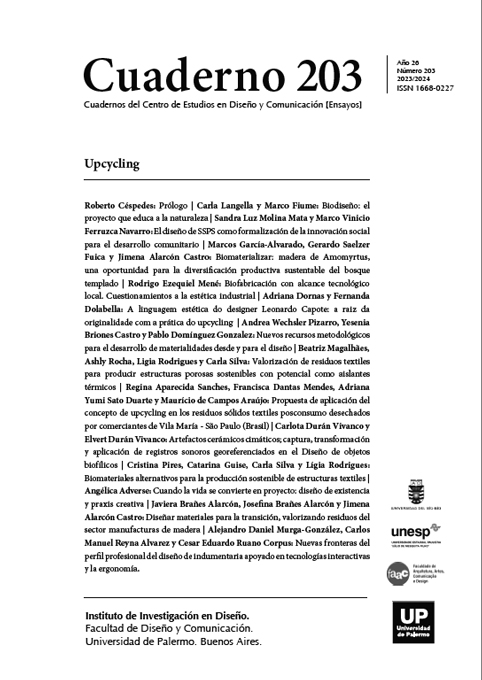Diseñar materiales para la transición, valorizando residuos del sector manufacturas de madera
Abstract
Recycling and reuse trends associated with material design suggest a change in thinking in the field of ideation.
References
Alarcón, J., Parra, X, &Droguett, C. (2017). Tableros en base a residuos de cebada de la industria agroalimentaria y adhesivos naturales: experiencia de una calidad percibida. Interciencia, 42(6), 364-369.
Alarcón, J., Briede, J., Di Bartolo, C., &Droguett, C. (2015). Valorización de cuero de vacuno residual de manufactura de calzado, como estrategia sustentable para elaboración de tableros De Pinus radiata enBío-Bío, Chile. Interciencia, 40(2), 138-144.
Alarcón, J., Rognoli, V., &LLorens, A. (2020). Diseñar para un escenario social incierto. el valor del enfoque materiales do-it-yourself y economía circula. Interciencia, 45(6), 279-285.
Arróyave, R., & McDowell, D. L. (2019). Systems approaches to materials design: past, present, and future. AnnualReview of MaterialsResearch, 49, 103-126.
Ashby, M. F. (2016). Chapter 1—Background: Materials, Energy and Sustainability. Materials and Sustainable Development; Ashby, MF, Ed.; Butterworth-Heinemann: Boston, MA, USA, 1-25.
Barati, B., Karana, E., &Hekkert, P. (2019). Prototyping materials experience: Towards a shared understanding of underdeveloped smart material composites. International Journal of Design, 13(2), 21-38.
Bergström, Jenny, et al. “Becoming materials: material forms and forms of practice.” Digital Creativity 21.3 (2010): 155-172.
Beylerian, G. M., Dent, A., & Quinn, B. (2008). Ultramateriales: formas en que la innovación en los materiales cambia el mundo. Blume.
Blanpain, B., Meskers, C. E., Olivetti, E., Apelian, D., Howarter, J., Kvithyld, A.,&Spangenberger, J. S. (2016). REWAS 2016: Towards materials resource sustainability. John Wiley & Sons.
Briede, J..,&Alarcón C, J. (2012). Sustainable strategies applied to regional context: design of wooden and unconventional raw materials boards for decorative finishing. Interciencia, 37(12), 927-933.
Chen, B. C., Silva, E. C., & Kikuchi, N. (2001). Advances in computational design and optimization with application to MEMS. International JournalforNumericalMethods in Engineering, 52(1-2), 23-62.
García, J. E., & Galán, T. R. (1998). La medida de las actitudes usando las técnicas de Likert y de diferencial semántico. Enseñanza de las Ciencias. Revista de investigación y experiencias didácticas, 16(3), 477-484.
Happaerts, S. (2014). International Discourses and Practices of Sustainable Materials Management, Policy Research Centre for Sustainable Materials Management, Report number: n° 5, Leuven. 12-13 pp.
Höök, K., Isbister, K., Westerman, S., Gardner, P., Sutherland, E., Vasalou, A., &Laaksolahti, J. (2011). Evaluation of affective interactive applications. Emotion-Oriented Systems: The Humaine Handbook, 687-703.
Karana, E., Nimkulrat, N., Giaccardi, E., Niedderer, K., & Fan, J. N. (2019). Alive. Active. Adaptive: Experiential knowledge and emerging materials. International Journal of Design, 13(2), 1-5.
López, Y. M., González, M. G., & Rodríguez, E. M. (2014). Impacto ambiental de residuos industriales de aserrín y plástico. Usos para la industria de tablero en Cuba. Avances, 16(2), 91-99.
Nathan, A., Ahnood, A., Cole, M. T., Lee, S., Suzuki, Y., Hiralal, P.& Milne, W. I. (2012). Flexible electronics: the next ubiquitous platform. Proceedings of the IEEE, 100(Special Centennial Issue), 1486-1517.
Parisi, S., Rognoli, V., Spallazzo, D., &Petrelli, D. (2018). ICS Materials. Towards a re- Interpretation of material qualities through interactive, connected, and smart materials. In Proceedings of DRS 2018-Design as a catalyst for change (Vol. 1, pp. 1747-1761). The Design Research Society.
Riikka, T., &Mikkonen, J. (2017). Signals as Material: From Knitting Sensors to Sensory Knits. In Alive. Active. Adaptive: International Conference on Experiential Knowledge and Emerging Materials, EKSIG 2017 (pp. 338-358). TU Delft Open.
Sanjuán, B. A. C. (2011). La gestión del Diseño según la Guía metodológica PREDICA. I+ Diseño: revista internacional de investigación, innovación y desarrollo endiseño, 5(5), 119-126.
Thackara, J. (2013). Diseñando para un mundo complejo: acciones para lograr la sustentabilidad.
Vergara, M., & Mondragón Donés, S. (2008). Ingeniería Kansei. Una potente metodología aplicada al diseño emocional.
Yoon, J., Kim, C., & Yoon, J. (2020). Positive user experience over product usage life cycle and the influence of demographic factors.
Los autores/as que publiquen en esta revista ceden los derechos de autor y de publicación a "Cuadernos del Centro de Estudios de Diseño y Comunicación", Aceptando el registro de su trabajo bajo una licencia de atribución de Creative Commons, que permite a terceros utilizar lo publicado siempre que de el crédito pertinente a los autores y a esta revista.


